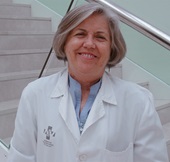Urolithiasis is an important cause of morbidity in the paediatric age group, with a global incidence of 2% to 3%. It manifests with acute and recurrent lumbar or abdominal pain (colic) that can have a significant impact on quality of life.1 Since its introduction in the 1980s, extracorporeal shock wave lithotripsy (ESWL) has become one of the most widely used techniques in the management of urolithiasis, in spite of which there is controversy about its efficacy and safety in paediatric clinical practice.2 We describe a cohort of patients aged less than 18 years with urolithiasis managed with ESWL in a referral hospital in the 2008–2022 period to assess the effectiveness and safety of this technique. The procedure was carried out under sedation and analgesia with pethidine hydrochloride alone or combined with midazolam using the Dornier DoLi SII lithotripter (Camelin, USA) (Fig. 1).
Positioning of the patient in supine position on the lithotripsy table under sedation and analgesia with pethidine hydrochloride and midazolam. The shock wave generator is placed in contact with the back at the level of the area to be treated while, from the other side, the fluoroscope guides the alignment of the generator to target the calculus and allows visualization of its fragmentation on the display. Image source: developed by the corresponding author.
A total of 5909 lithotripsies were performed during the study period, out of which 1% corresponded to patients under 18 years (n=59): median age, 7 years (range, 1–17), 50% female (n=30). The average size of the stones was 1cm (range, 0,8–4). Seventy-eight percent of patients had a single stone (n=46), 10% had 2 (n=6) and 12% had 3 or more (n=7). In 36 patients (61%) the stones were located in the kidney, in 20 (33%) they were in the ureter, in 2 they were in the bladder, and a single patient had nephroureterolithiasis (Fig. 2). The mean duration of treatment was 45minutes (SD, 18), the mean number of shock waves 2135, the mean maximum wave intensity 8kV (SD, 3) and the mean duration of fluoroscopy was 4.2minutes (SD, 3). The mean radiation dose was 11Gy/cm2 (SD, 10.5). Kidney stone analysis was only performed in 11 of the patients, showing that the calculi were most frequently made of calcium oxalate+calcium phosphate (3/11) or calcium oxalate (3/11), followed by calcium phosphate (2/11), apatite+calcium phosphate (2/11) and cystine (1/11). Fifteen patients required repeated treatment (25%): 9/15 one additional session (60%), 4/15 two sessions and 2/15 four sessions (13%) due to early recurrence. The incidence of complications following ESWL was 10% (n=6/59), in 4 cases it was abdominal pain, which required admission for analgesia in only one of the patients, and in the other 2 cases the complications were fever with leukocyturia with a negative urine culture. There were no cases of steinstrasse post ESWL. Since the treatment was provided in a referral hospital, many patients were followed up in other centres, so we lost 21 of the 59 children to follow-up (35.5%). In the 38 cases that we were able to follow-up, the success rate (success defined as absence of lithiasis or residual stones < 3mm) was 84% (n=32) at 12 months post treatment. In these patients, we conducted a stratified analysis of the success rate by age group: 0–6 years (n=15) 93% 6.1–12 years (n=11) 72% and 12.1–18 years (n=12) 83%, with no statistically significant difference (P=.109). There were also no statistically significant differences between age groups in the size or location of the stones (P=.083 and P=.231, respectively); although ESWL was more effective in children with nephrolithiasis aged 0–6 years (100%) compared to those aged 6–12 years (57%) or 12–18 years (80%).
Different imaging modalities and calculi locations. Computed tomography scan showing 2 renal calculi (A, arrow), plain radiograph of the abdomen showing one calculus in the left kidney (B, arrow), ultrasound scan showing cystolithiasis (C) and a distal ureteral calculus (D, arrow).
Urolithiasis, with its broad clinical spectrum, has motivated the investigation of different therapeutic approaches based on the location, size and composition of the calculi.1,2 In the treatment of renal or proximal ureteral stones measuring less than 2cm, the effectiveness of ESWL has been found to be comparable to that of ureteroscopic laser lithotripsy in terms of the rate of success (21%–90% compared to 37%–97%), the incidence of complications and the need for reintervention.3,4 Although the success rate with flexible ureteroscopy is slightly greater, ESWL is less invasive and does not require general anaesthesia. For stones larger than 2cm in the renal pelvis, the reported success rate of ESWL is 96%,5 similar to what we observed in our cohort (84%). Comparing the efficacy of ESWL in adults and children, the success rate tends to be higher in the latter (68% vs 80%; P=.036)6; in fact, in our analysis stratified by age, the effectiveness of ESWL did not vary significantly between the age groups, which supported its applicability in the entire paediatric age spectrum. Furthermore, the current evidence suggests that children could benefit more from ESWL and need fewer additional procedures compared to adults. As regards the complications after ESWL, the reported incidence is 15% in adults and 13% in children.3–6 Although certain factors, such as the body mass index, location and size of the calculi can have an effect on the probability of success, our findings support the effectiveness of ESWL in paediatric patients. Its noninvasive nature, reproducibility, high success rates and low incidence of complications are among the advantages that could warrant contemplating ESWL as an alternative first-line treatment for paediatric urolithiasis in various locations of the urinary tract, even for stones greater than 2cm. However, the current scientific evidence is scarce and randomised controlled trials in representative samples still need to be conducted.









